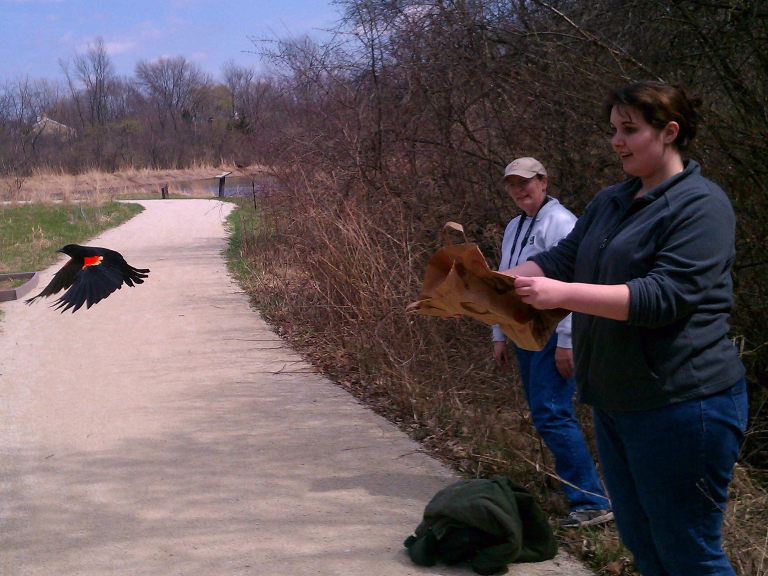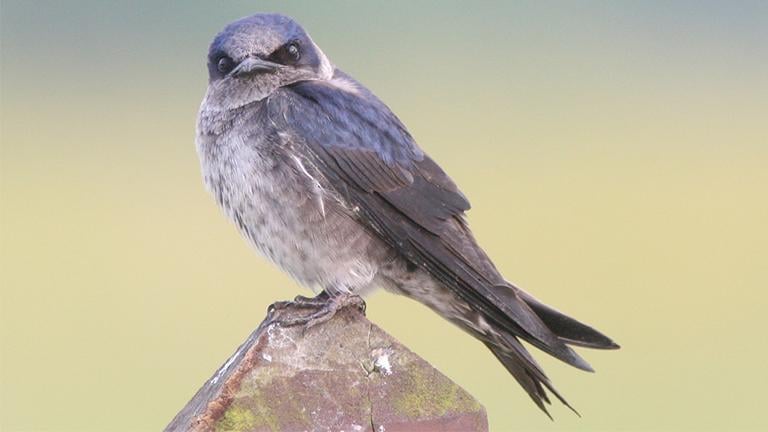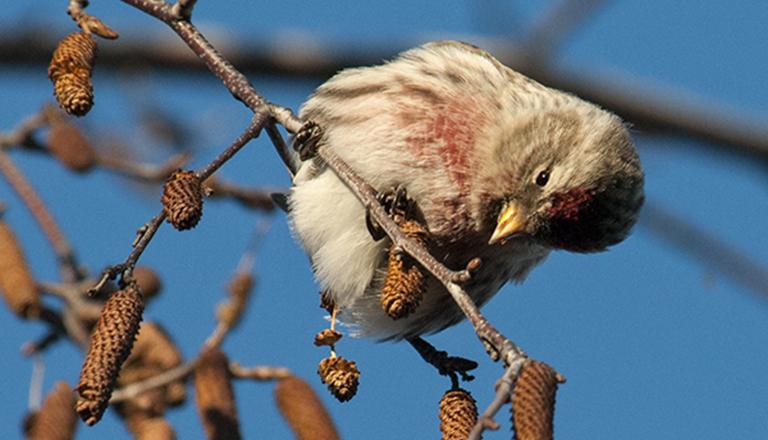useless birds accrued via the Chicago hen Collision screens and given to the field Museum's fowl Division. (Josh Engel / The container Museum)
every spring and fall, a gaggle of volunteers hits the Loop in downtown Chicago earlier than the morning rush, cautiously combing the streets. What are they searching for? lifeless and injured birds.
seeing that 2003, the Chicago chicken Collision monitors (CBCM) has made it their mission to collect birds which have been killed or injured after outstanding structures and other buildings. in line with the community's director, Annette Prince, the CBCM collects an annual normal of about 5,000 birds inside the city and roughly three,000 birds from the improved Chicago enviornment. The breakdown of fowl casualties tends to be 60 p.c dead and 40 percent injured.
 Annette Prince, director of the Chicago hen Collision screens, holds a rescued northern flicker, some of the extra common hen species the neighborhood finds during its patrols. (Chicago fowl Collision displays) considering that most collisions turn up early within the morning, Prince says, the CBCM conducts its surveys from simply before break of day unless about midmorning.
Annette Prince, director of the Chicago hen Collision screens, holds a rescued northern flicker, some of the extra common hen species the neighborhood finds during its patrols. (Chicago fowl Collision displays) considering that most collisions turn up early within the morning, Prince says, the CBCM conducts its surveys from simply before break of day unless about midmorning.
"It may also be a generally neglected issue that receives swept up or washed away," stated Prince.
Prince is rarely talking metaphorically. She's relating to the lifeless birds that are actually swept up and disposed of each morning by way of constructing renovation crews, metropolis people and others all through the spring and fall migratory chicken seasons.
Injured birds discovered by using the CBCM are taken to the Willowbrook natural world center in west suburban Glen Ellyn and the useless birds are given to the container Museum's chook division, which takes tissue samples from specimens and catalogues them for analysis.
"The beauty of working with an institution like the container Museum is that these birds can serve a intention as opposed to just being thrown in trash cans," Prince mentioned.
A Baltimore oriole at the box Museum that turned into discovered outdoor of the Franklin middle by means of the Chicago fowl Collision screens. (Josh Engel / The field Museum)
An estimated a hundred,000 to 1 billion birds die every year from colliding into structures in North the us.
Chicago's location on the Mississippi Flyway migratory hen route and Lake Michigan make it a major stopover for hundreds of thousands of birds heading to summer breeding grounds in northern U.S. states and Canada or, within the fall, to overwintering areas as far as South the usa.
For hundreds of birds every year, however, Chicago is their closing resting region.
"These are birds coming from tropical rainforests that don't have lots of experience with city Chicago apart from both instances of year that they flow through here," Prince observed.
throughout the day, birds are killed or seriously injured after flying into windows or mirrored surfaces of constructions as a result of they fail to notice reflective or transparent surfaces. A inn lobby's bubbling fountain, furnishings or indoor plants may also look like welcome resting spots for birds that don't see the glass setting apart them from the objects inner.
Birds migrating at night, reminiscent of songbirds, e book themselves through the light of the moon and stars. in keeping with the Audubon Society, the unnatural glow of the city's skyline throws these birds off their migratory flight course. The birds then circle these buildings until they both collide into them or die from exhaustion. for this reason, the application Lights Out, subsidized with the aid of the Chicago Audubon Society, encourages building house owners to turn off their lights between 11 p.m. and daybreak all over migratory hen seasons.
An injured yellow-bellied sapsucker recovers inside the defense of a brown paper bag. (Chicago fowl Collision monitors)
Prince pointed out some birds that live on a collision are stunned for a number of moments before regaining full consciousness. These first few seconds after a crash are important as different animals in the area have realized to capitalize on the chicken-meets-building collision issue.
"Crows and gulls have dived down ahead of us and grabbed lifeless and are living birds," Prince observed. "I've viewed rats grab birds. These different animals have learned that it's a food supply and that they actively patrol areas downtown the place the birds are found. I've even seen gulls drive little birds toward windows and once they strike the window, they seize them whereas they're falling."
Prince argued this isn't the "typical circle of lifestyles," as birds like warblers and hummingbirds would broadly speaking be capable of outfly and outmaneuver the better crows and gulls, however the city's landscape poses an important impediment to puzzled migratory birds.
![]()
"I'm simply dismayed that some thing as appealing because the Chicago skyline will also be so deadly for birds."
–Annette Prince
a particularly devastating point of this issue for Prince is that migratory birds found lifeless in Chicago have typically travelled very a long way and don't have lengthy to head before accomplishing summer season nesting habitats in areas north of Chicago. These are the exemplars of their species – the strongest, most resilient birds of their flock to make it this far.
"These birds weigh a number of ounces and that they fly lots of miles from South the united states – it's fairly impressive," Prince observed. "They've prevented predation, storms, hunger and hitting windows in states south of here, but meet their tragic conclusion here.
"Glass doesn't make a choice from the susceptible or potent. So we're losing very crucial contributors of hen species. "
in the conclusion, Prince places the onus on architects, now not constructing managers or employees, to tackle the difficulty by way of designing buildings that are greater chook-friendly. That could imply putting patterns on home windows to alert birds of the floor.
 A Chicago fowl Collision displays volunteer releases a rehabilitated pink-winged blackbird into a DuPage County wooded area hold. Birds which are rehabilitated on the Willowbrook flora and fauna core are released into the appropriate wild habitat in response to their species. (Kolton Turner / Chicago fowl Collision screens)
A Chicago fowl Collision displays volunteer releases a rehabilitated pink-winged blackbird into a DuPage County wooded area hold. Birds which are rehabilitated on the Willowbrook flora and fauna core are released into the appropriate wild habitat in response to their species. (Kolton Turner / Chicago fowl Collision screens)
more than 100 volunteers take part within the CBCM, which also responds to calls, by the use of an emergency telephone line, from residents in and outdoors the metropolis who've discovered an injured bird or an unaccompanied child hen.
The neighborhood is now nearing the tail conclusion of this yr's spring migration, right through which they patrol from mid-March via early June. within the fall, the community is energetic from mid-August except early November. Their patrol latitude is the Chicago Loop with a southern boundary of Congress Parkway.
Residents can learn how to make their homes safer for traveling birds on the CBCM's web page. they can also volunteer to be a part of the CBCM via attending a two-hour advice session. The subsequent round of periods begins in August, forward of fall migration.
For Prince, the enjoyment of Chicago's skyline as well as a traveling inhabitants of distinct birds may still not be mutually unique.
"i really like birds," Prince observed. "I desire them a more robust destiny than they have. however I additionally love the Chicago skyline, architecture and structures. I'm simply dismayed that whatever as beautiful as the Chicago skyline can be so lethal for birds."
comply with Evan Garcia on Twitter: @EvanRGarcia
register for our morning e-newsletter to get all of our reports delivered to your mailbox each weekday.
linked 'Chicago Tonight' stories
 Why purple Martins need a bit Human help
Why purple Martins need a bit Human help
may also 6: The migratory birds are beginning to nest in the area, but their nests don't appear to be those present in timber. it really is as a result of red martins, which spend their winters in South the united states, now count practically wholly on man-made nests once they arrive every spring.
 Photographer art Fox Shares 'damaged experience' of Migratory Birds
Photographer art Fox Shares 'damaged experience' of Migratory Birds
April 25: The lengthy voyage of some migratory birds ends in Chicago. How photographer paintings Fox is elevating recognition of what is referred to as "window kill" at the Peggy Notebaert Nature Museum.
 individual Birds consult with Chicago in iciness
individual Birds consult with Chicago in iciness
January 12: Birds now not generally found in Chicago seek advice from the area right through the winter to make the most of herbal – and man-made – components.
Tidak ada komentar:
Posting Komentar